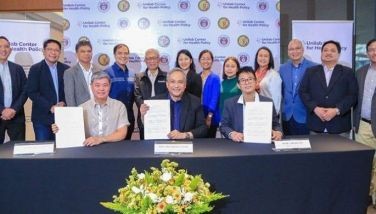Thanks, P-Noy

Thanks, but no thanks. President Benigno Simeon Aquino III, or P-Noy, could very well have spoken these words to his administration allies in the 15th Congress. Acting obsequiously to win the good graces of the Palace, certain lawmakers sought to grant President Aquino with emergency powers to purportedly put a stop to the worsening long hours of blackouts in Mindanao.
No matter how well meaning such proposals were put forth, there is simply no valid ground for the government to cut deals as immediate solution to the looming power shortage crisis in Mindanao. Certain lawmakers seem to have the mistaken notion that every problem in this country can be solved through legislation.
On the contrary, purported remedial legislation at times creates more problems. It is like the cure makes the illness worse. A good example of this is Republic Act 9136, otherwise called the Electric Power Industry Reform Act (EPIRA) of 2001. The centerpiece program of EPIRA is the privatization of the government-owned National Power Corp. (Napocor).
Due to long years of mismanagement and corruption in the bureaucracy of this government-owned corporation, the resulting heavy financial losses and huge foreign debts seriously impaired the operations of the power plants run by Napocor.
As envisioned by our lawmakers, EPIRA has three main objectives: (1) to develop indigenous resources; (2) to cut the high cost of power in the Philippines; and (3) to encourage foreign investment. Its passage was supposed to set into motion the deregulation of the power industry and eventual privatization of state-owned power enterprises.
Actual sale to private sector of state assets of Napocor and implementation of the privatization program under EPIRA was targeted to take place sometime late 2002 or early 2003. In order to make Napocor more attractive to investors, the government absorbed a significant amount of Napocor’s $6.7-billion debts. And we taxpayers carry that Napocor debts burden up to now in the annual budget of the national government that Congress approves each year.
As mandated by the EPIRA, several spin-off companies were created out of Napocor to carry out the privatization program. These include, namely, the Power Sector Assets and Liabilities Management Corp. (PSALM); National Transmission Corp. (Transco); and Generating Companies (Gencos).
But just like any other laws passed by Congress, it took several years before some of these Napocor power plants, transmission and other assets were finally sold to the private sector.
It was only in 2008 when Transco was finally privatized. It was bought by One Taipan Holdings Inc. of Henry Sy Jr. and is now called the National Grid Corp. of the Philippines (NGCP). So far, a number of power plants under Gencos were sold already to the private sector and are now being operated more efficiently by its new owners like the Aboitizes, the Lopezes who own the Manila Electric Co. (Meralco), San Miguel Corp. etc.
After the privatization of its power facilities, Napocor would be left with the function of operating power plants not sold by PSALM. PSALM also manages Napocor’s power plants and debtss. Some of these unsold assets up to now include the Agus and Pulangi hydroelectric power plants in Mindanao.
In addition to Napocor debtss, the $9 billion in power purchase agreements (PPA) it entered with independent power producers (IPPs) will also be sold off. Yes, these are the same IPPs which we are still paying for our electricity, including the unused or excess electricity on stream.
These PPAs were entered into by Napocor with these IPPs under the emergency powers granted in 1992 by the previous Congress to former President Fidel V. Ramos.
The Ramos administration was forced to contend with the power supply deficit due to the mothballing of the 621-megawatt (MW) Bataan nuclear power plant (BNPP) in Morong. It was the administration of the late mother of P-Noy, former President Corazon Aquino that decided to mothball the BNPP. But no new base-load power plant equivalent to the electric generation capacity was put up in place of BNPP.
For a limited period of time, Mr. Ramos used his emergency powers to close the huge gap of power supply in the Luzon grid when there were eight to 12 hours of blackouts during those times. These PPAs included the “take-or-pay” provision that guaranteed IPPs of return to attract investments.
The other day it was reported the Energy Regulatory Commission (ERC) has approved on March 26 the pending rate adjustment petitions by Napocor and the PSALM to enable them to recover costs incurred from 2007 to 2010. Based on the ERC decision, electricity rates for Luzon are up by 69.04 centavos per kilowatt-hour (kwh); Visayas, 60.60 centavos per kwh; and Mindanao, 4.42 centavos per kwh effective this May.
Speaking of ERC, the EPIRA authorized it to determine the universal charge. This gave distribution utilities like Meralco and Napocor the right to pass on the burden of paying for stranded costs under the IPP contracts to consumers.
Thus, more than a decade after its passage into law, EPIRA is obviously no cure-all to the problems of stable and affordable supply of electric power in our country. That is why there have been persistent calls to amend the EPIRA to correct the flaws of this law to really achieve its mandate to bring down the cost of electricity in our country, which is the highest in this part of the world.
Congress giving him emergency powers will not solve it. Let’s face it. Legislators will always try to suit their own selfish interests into the laws they craft.
Now as the Chief Executive of the land, P-Noy only knows too well how they do things in Congress. After all, Noy served for nine years as Tarlac congressman and three years at the Senate.
Noy was a neophyte congressman when Congress passed into law EPIRA in 2001. For lack of time, I could not check if Noy voted for the passage of EPIRA. Nonetheless, we could still thank P-Noy for opting out of emergency powers. We could thank him further if he pushes Congress to revisit instead EPIRA.
- Latest
- Trending


























